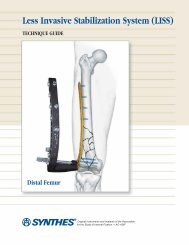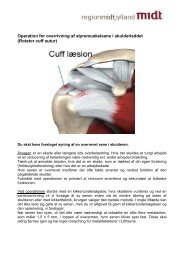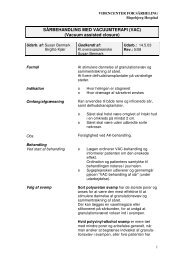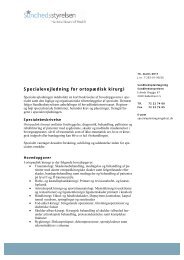TightRope™ Syndesmosis Fixation - DrStorm
TightRope™ Syndesmosis Fixation - DrStorm
TightRope™ Syndesmosis Fixation - DrStorm
You also want an ePaper? Increase the reach of your titles
YUMPU automatically turns print PDFs into web optimized ePapers that Google loves.
TightRope <strong>Syndesmosis</strong> <strong>Fixation</strong><br />
Surgical Technique<br />
TightRope <strong>Syndesmosis</strong> <strong>Fixation</strong>
TightRope <strong>Syndesmosis</strong> <strong>Fixation</strong><br />
1<br />
2<br />
Drill all four cortices, 1.5 cm above the ankle joint, in the<br />
transmalleolar plane (30˚ anterior to the coronal plane), using<br />
the 3.56 mm drill bit. The needle and pull-through sutures<br />
are passed along the drill hole and out the intact medial skin.<br />
Care should be taken to avoid the saphenous vein and nerve<br />
(anterior to medial malleolus).<br />
3 4<br />
Cut the green/white and white pull-through sutures where<br />
they connect to the needle after passage through the medial<br />
skin. Slight upward tension should be placed on the white<br />
pull-through suture, while placing downward tension on the<br />
green/white suture. The button should seat easily along the<br />
medial cortex. Confirm placement using C-ARM.<br />
Note: Toggling the two pairs of #5 FiberWire on the lateral<br />
side will also aid in seating the medial button.<br />
The white 2-0 FiberWire pull-through suture advances<br />
the leading oblong button, which continues longitudinally<br />
along the drill hole, until it just exits the medial tibial cortex.<br />
(Note: The green/white 2-0 FiberWire suture has been<br />
added to help facilitate placement of the medial button during<br />
step 3. Do not tension the green/white suture while<br />
passing the button from the fibula through the tibia). It<br />
should remain slack as it passes through the drill hole.<br />
The white and green/white pull-through sutures are cut<br />
and removed. The trailing lateral button is tightened<br />
down on the lateral side by pulling on the free ends of the<br />
syndesmosis suture with the syndesmosis reduced (internal<br />
rotation and moderate ankle plantar flexion).
5<br />
The construct is secured with three half-hitches. The<br />
suture ends are cut about 1 cm long to allow the knot<br />
and suture to lay down, reducing knot prominence.<br />
B<br />
Lateral<br />
Left leg<br />
Anterior<br />
Posterior<br />
Medial<br />
A second TightRope should be used to treat Maisonneuve<br />
injuries, or if further syndesmosis stability is required. The<br />
second TightRope should be placed 1 cm above the first,<br />
with slight axial divergence to increase rotational stability.<br />
(see illustration B and x-ray insets)<br />
A<br />
Repair is complete using one TightRope.<br />
Surgical Technique<br />
Postoperative Management<br />
Following wound closure, immobilize the ankle in the neutral<br />
position in a below-knee cast, nonweight-bearing for the<br />
first two weeks. Depending on fracture fixation stability and<br />
satisfactory wound healing, partial weight-bearing (50% body<br />
weight) may then be permitted in cast or walker boot, until<br />
six weeks postoperatively. Full weight-bearing can be allowed<br />
out of cast at six weeks.<br />
Implant Removal<br />
Routine removal of the TightRope is not required. If, for<br />
any reason it needs removal; small incisions over both buttons<br />
and cutting the suture makes removal of the buttons<br />
and suture easy.
TightRope Plus <strong>Syndesmosis</strong> Repair Kits:*<br />
TightRope Plus <strong>Syndesmosis</strong> Repair Kit, titanium, sterile, SU AR-8924DS<br />
TightRope Plus <strong>Syndesmosis</strong> Repair Kit, stainless steel, sterile, SU AR-8925DS<br />
TightRope Plus <strong>Syndesmosis</strong> Kits include:<br />
• Drill Bit, 3.56 mm<br />
• Drill Guide, disposable<br />
• 3.5 mm x 10 mm oblong Button (medial side placement)<br />
• 6.5 mm Round Button (lateral side placement)<br />
• #5 FiberWire Suture (blue)<br />
• 2-0 FiberWire (white)<br />
• 2-0 FiberWire (green/white)<br />
• Guidewire, 1.6 mm (with pull-through suture, white and green/white)<br />
TightRope <strong>Syndesmosis</strong> Repair Kits, cannulated:*<br />
TightRope <strong>Syndesmosis</strong> Repair Kit, cannulated, titanium, sterile, SU AR-8920CDS<br />
TightRope <strong>Syndesmosis</strong> Repair Kit, cannulated, stainless steel, sterile, SU AR-8921CDS<br />
TightRope <strong>Syndesmosis</strong> Repair Kits, cannulated, include:<br />
• Guidewire for TightRope <strong>Syndesmosis</strong> Kit, 1.2 mm<br />
• Drill Bit, 3.56 mm<br />
• Drill Guide, disposable<br />
• 3.5 mm x 10 mm oblong Button (medial side placement)<br />
• 6.5 mm Round Button (lateral side placement)<br />
• #5 FiberWire Suture (blue)<br />
• 2-0 FiberWire (white)<br />
• Guidewire for TightRope <strong>Syndesmosis</strong> Kit, 1.2 mm<br />
Accessories:<br />
• Cannulated Drill Bit, 3.56 mm AR-8920DC<br />
• Guidewire for TightRope <strong>Syndesmosis</strong> Kit, 1.2 mm AR-8920P<br />
Button Design (actual size)<br />
Lateral Buttons Medial Button<br />
front back<br />
SU Single Use U.S. PATENT NO. 6,716,234 and PATENT PENDING<br />
*Note: Titanium kit to be used with titanium plate and screws. Stainless steel kit to be used with stainless steel plates and screws.<br />
TighTRope AwARds<br />
“Orthopaedics Today” Prize for Technological Advancement, British Orthopaedic Association Annual<br />
Congress, 2003, Birmingham, UK<br />
“Medical Futures”, Best Medical Device Innovation 2003, UK<br />
“Cutlers Prize”, an Annual Award for the Best Advance in Surgical Instrumentation, 2004
Arthrex TightRope<br />
The Arthrex <strong>Syndesmosis</strong> TightRope provides fixation of syndesmosis<br />
disruptions with or without associated ankle fractures. The TightRope is<br />
a low profile system comprised of a #5 FiberWire ® loop which, tensioned<br />
and secured between metallic buttons placed against the outer<br />
cortices of the tibia and fibula, provides physiologic stabilization of<br />
the ankle mortise. Biomechanical testing and clinical trials have shown<br />
equivalent strength and improved patient outcome with the TightRope<br />
technique. The TightRope obviates the need for a second procedure for<br />
removal, therefore late diastasis cannot occur. Weight-bearing may be<br />
commenced earlier than with screw fixation, as cyclic loading does not<br />
promote device failure. The “snowshoe” hold on cortical bone makes<br />
the TightRope suitable in osteoporotic bone where polymer or metallic<br />
screws cut out.<br />
Advantages<br />
• No need for routine removal<br />
• Eliminates broken screw complications<br />
• Achieves strong, anatomic and flexible fixation<br />
• Simplifies lateral insertion technique<br />
• Facilitates double TightRope technique for Maisonneuve fracture<br />
Indications<br />
The TightRope is intended to provide syndesmosis fixation during<br />
the healing process following a syndesmotic trauma, usually seen with<br />
Weber B and C ankle fractures.<br />
<strong>Syndesmosis</strong> Reduction<br />
The syndesmosis should be formally reduced prior to fixation and<br />
confirmed using fluoroscopy. Internal rotation in moderate ankle<br />
plantar flexion is the usual method of reduction. Dorsiflexion of the<br />
ankle to reduce is not recommended as it may cause malreduction and<br />
compromise the end result. Overtightening of the syndesmosis will not<br />
occur using the TightRope.<br />
Fracture <strong>Fixation</strong><br />
Fractures in the lower half of the fibula should be rigidly and anatomically<br />
fixed to ensure correct fibular length and rotation. High fibula<br />
fractures (Maisonneuve injury) can be managed by reduction and<br />
syndesmosis fixation only, using two TightRopes.
Arthrex, Inc.<br />
1370 Creekside Boulevard, Naples, Florida 34108-1945 • USA<br />
Tel: 239-643-5553 • Fax: 239-598-5534 • Web site: www.arthrex.com<br />
Arthrex GmbH<br />
Liebigstrasse 13, D-85757 Karlsfeld/München • Germany<br />
Tel: +49-8131-59570 • Fax: +49-8131-5957-565<br />
Arthrex Iberoamérica<br />
Howard Hughes Tower, 6701 Center Drive West, Suite 550, Los Angeles, California 90045 • USA<br />
Tel: 310-670-6080 • Fax: 310-670-6087<br />
Arthrex S.A.S.<br />
5 Avenue Pierre et Marie Curie, 59260 Lezennes • France<br />
Tel: +33-3-20-05-72-72 • Fax: +33-3-20-05-72-70<br />
Arthrex Canada<br />
Lasswell Medical Co., Ltd., 405 Industrial Drive, Unit 21, Milton, Ontario • Canada L9T 5B1<br />
Tel: 905-876-4604 • Fax: 905-876-1004 • Toll-Free: 1-800-224-0302<br />
Arthrex GesmbH<br />
Triesterstrasse 10/1 • 2351 Wiener Neudorf • Austria<br />
Tel: +43-2236-89-33-50-0 • Fax: +43-2236-89-33-50-10<br />
Arthrex BvbA<br />
Technologiepark Satenrozen, Satenrozen 1a, 2550 Kontich • Belgium<br />
Tel: +32-3-2169199 • Fax: +32-3-2162059<br />
Arthrex Ltd.<br />
Unit 16, President Buildings, Savile Street East, Sheffield S4 7UQ • England<br />
Tel: +44-114-2767788 • Fax: +44-114-2767744<br />
Arthrex Hellas - Medical Instruments SA<br />
103, Ethnikis Antistasseos str., N. Psichico 154 51 Athens • Greece<br />
Tel: +30-210-8079980 • Fax: +30-210-8000379<br />
Arthrex Sverige AB<br />
Turbinvägen 9, 131 60 Nacka • Sweden<br />
Tel: +46-8-556 744 40 • Fax: +46-8-556 744 41<br />
Arthrex Korea<br />
Rosedale Building #1137, 724 Sooseo-dong, Gangnam-gu, Seoul 135-744 • Korea<br />
Tel: +82-2-3413-3033 • Fax: +82-2-3413-3035<br />
Arthrex Mexico, S.A. de C.V.<br />
Insurgentes Sur 600 Mezanine, Col. Del Valle Mexico D.F. 03100 • Mexico<br />
Tel: +52-55-91722820 • Fax: +52-55-56-87-64-72<br />
Arthrex Swiss AG<br />
Müllerenstrasse 3, 8604 Volketswil • Switzerland<br />
Tel: +41-43-399-45-20 • Fax: +41-43-399-45-29<br />
This description of technique is provided as an educational tool and clinical aid to assist properly licensed medical<br />
professionals in the usage of specific Arthrex products. As part of this professional usage, the medical professional must<br />
use their professional judgment in making any final determinations in product usage and technique.<br />
In doing so, the medical professional should rely on their own training and experience and should conduct<br />
a thorough review of pertinent medical literature and the product’s directions for use.<br />
Developed in conjunction with Brian Thornes, M.D., Dublin, Ireland.<br />
© Copyright Arthrex Inc., 2007. All rights reserved. LT0426E






